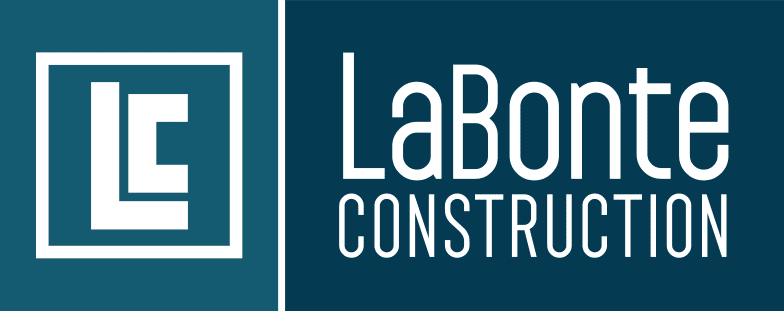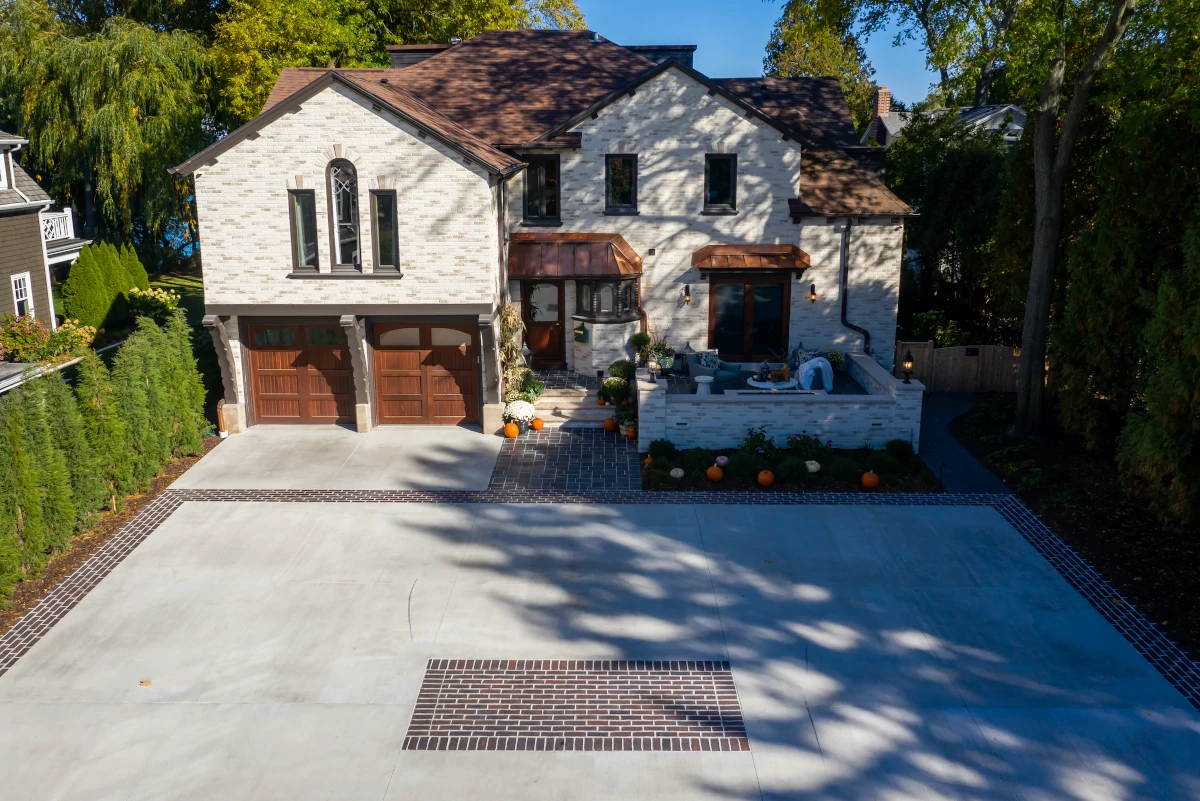Selecting the right type of roof for your home remodeling project is important; after all, it is your home’s first line of defense from the elements above. This guide to roofs will help you make the best choice.
Roofs come in many different slopes, designs and materials. Our builders at LaBonte Construction have decades of remodeling experience and can ensure that the roof for your next home remodeling project is of the highest quality.
Guide to Roofs: Roof Designs
We divide roof designs in to two main categories: flat roofs and sloped roofs.
Flat Roofs
We generally use flat roofs on commercial buildings, but we also use them on certain areas of a home. We most commonly install flat roofs on modern homes or home remodels. The average thickness of a flat roof material is anywhere from 45 to 90 mm. Manufacturers make a variety of materials for flat roofs, but all generally have a similar design.
Sloped Roofs
Sloped roofs are the more common type of roof for residential use. Because they have a slope to them, rain and snow slide off more easily. There are five main designs of sloped roofs: Gable, Saltbox, Gambrel, Mansard and Hip.
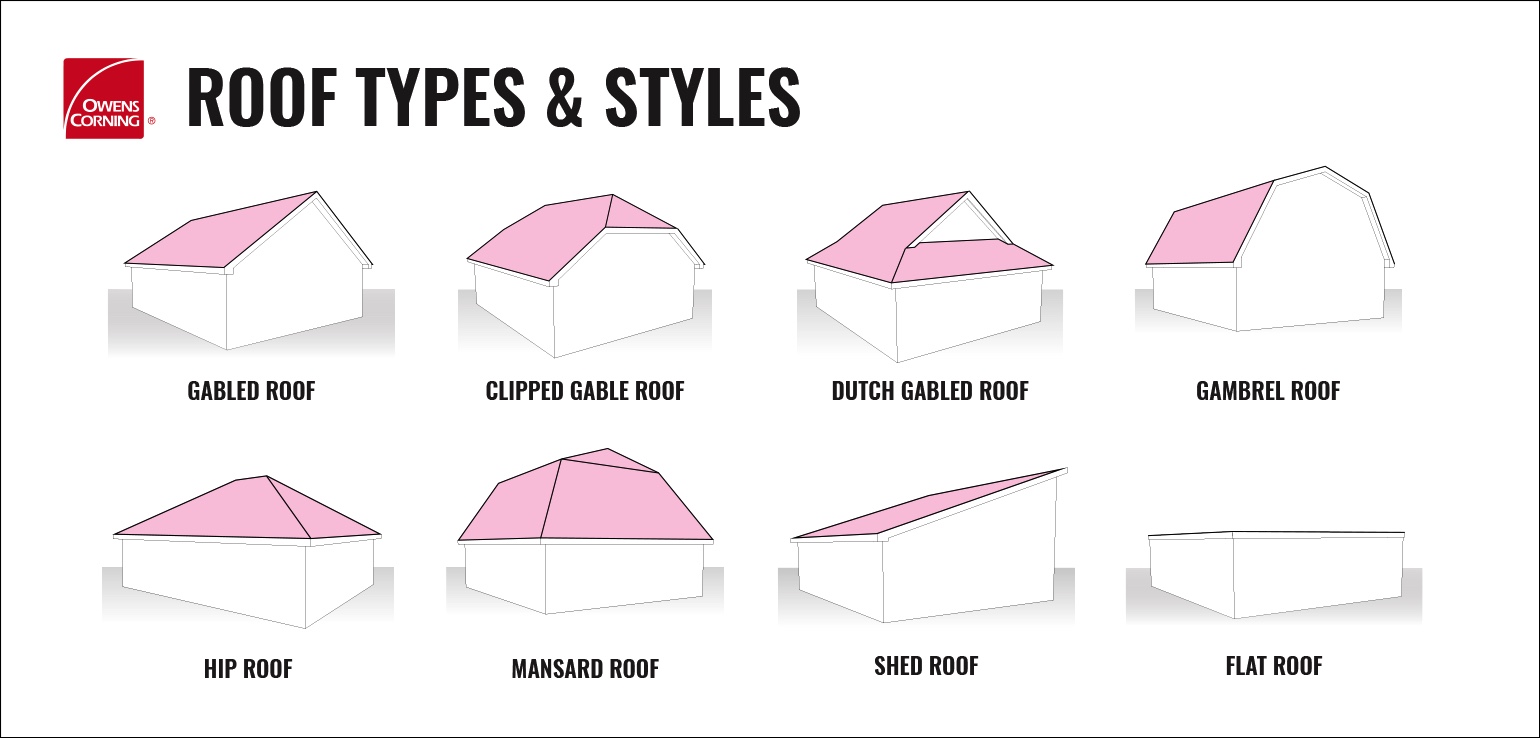
Gable
This is the most common sloped roof in use today, and also the simplest. A gable roof consists of two rectangular, usually equal sized panels that join each other at an angle to form a ridge on the top of the home.
Saltbox
Saltbox roofs are very similar to gable roofs as they join together at an angle to form a ridge on the top of the home. However, the difference between the two is that one of the rectangular panels on a saltbox roof is longer than the other. Saltbox roofs originated in 17th and 18th century colonial homes, when an addition was added to the back of the first floor.
Gambrel
The gambrel roof is most commonly seen on barns or country style homes. This roof design consists of two equal sized panels on each side, but the slope of the upper portion of the roof is much shallower, whereas the slope of the lower portion of the roof is much steeper. This type of roof can help increase space in the upper areas of a home, while still maintaining the characteristics of a sloped roof.
Mansard
The mansard roof has four different sides that slope downward with a flat top. Mansard roofs are widely used in European style homes, and the design originated in France. Many see this design style as a sign of elegance.
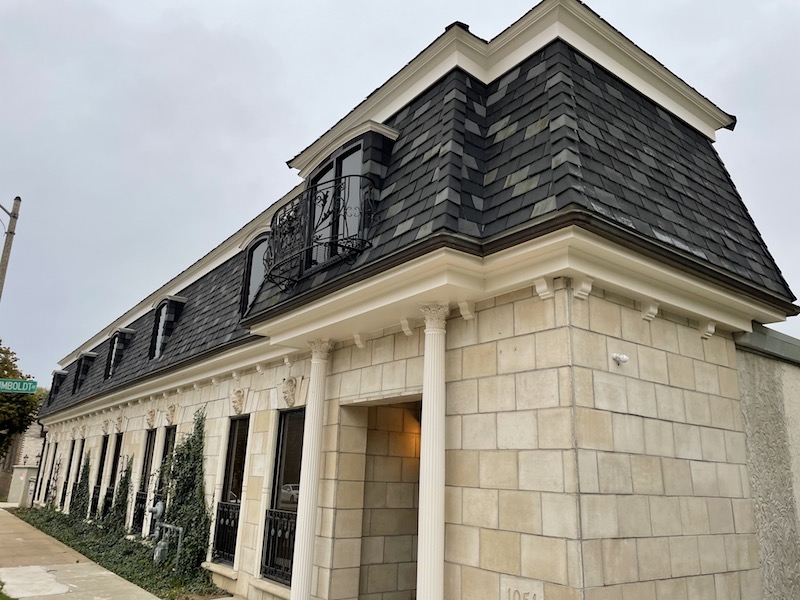
Hip
A hip roof is a four-sided roof in which all sides of the roof slope downwards. This design style is typically used on smaller homes or smaller sections of a home. Generally, the slope of a hip roof is much lower than the slope of other roof designs.
Guide to Roofs: Pitch
Pitch is the slope of your roof. This determines what type of roof will be the best fit for your home. Pitch is a ratio of the number of inches of rise per run of horizontal foot on a roof.
| Type | Pitch Ratios Included (in inches) |
|---|---|
| Flat Roof | 1/2:12 up to 2:12 |
| Low Slope | Up to 4:12 |
| Conventional | 4:12 to 9:12 |
| Steep Roof | Above 9:12 |
Climate conditions are a major factor when deciding what pitch your roof should have. For those in areas that receive a lot of precipitation, we recommend a steeper roof. However, in places like Wisconsin where there is significant snowfall, a roof that is too steep can be dangerous as snow could slide off and possibly fall on a passerby. This is why selecting the right pitch for the roof is of the upmost importance.
Sloped Roof Materials
After deciding what style and pitch is best for your home remodeling project, its time to select the material for your roof. There are many different options to choose from, offering different aesthetics and varying degrees of quality.
Metal Roofs
Metal roofs are fast becoming the preferred option of many homeowners because they can provide more durability and stability when compared to traditional asphalt shingles.
Although some refer to them to as tin roofs, they are mostly made out of rolled steel. Manufacturers make this by chemically bonding a thin layer of tin to the steel. The lifespan of tin roofs is typically up to 40 years, and is an eco-friendly option because it is made from 30-60 percent recycled materials. Additionally, one of the biggest benefits to using a metal roof is that you can save on insurance premiums, as insurance companies consider them superior to asphalt shingles. There are numerous types of metals used for roofing material.
Standing Seam
The most common metal roof material in use today is the standing seam. Most companies make these panels out of Galvalume-coated steel, but some make them from aluminum, copper and various other metals. Standing seam roofs perform particularly well in harsh weather conditions and can last up to 50 years if properly installed.
Aluminum
Aluminum roofs offer more flexibility than many of the other metals used in roofing, and is one of the longest-lasting metal roof options, with most lasting 40 years or more. This material is also quick to cool after heating up, and can be fire resistant with the addition of a fire barrier. Just like standing seam, aluminum roofs stand up well to serve weather, which is important during our Wisconsin winters.
Galvanized Steel
Galvanized steel is the quintessential metal roof. The steel has been coated with zinc to make it more resistant to cracking, shrinking and erosion. It typically lasts anywhere from 15-30 years, is energy efficient, and is recyclable. The biggest reason that builders used galvanized steel is that the galvanization process inhibits rust.
Copper
One of the longest-lasting metal roof materials is copper; it can have a lifespan of 60+ years. While it is one of the more expensive metal roof materials, it lasts far longer than most and is naturally fire resistant. It is common for copper to oxidize and turn green around twenty years into its use, however you can ask your home remodeling contractor to put on a clear polyurethane or clear lacquer during installation to preserve the copper’s natural color. Additionally, manufacturers add lead coatings to copper roofs to change its color.
Zinc
Zinc is the longest-lasting metal roof material available. It has a lifespan of up to 100 years and is resistant to cracks and erosion. Zinc is easily foldable which makes it great for unique roof designs. Even though it is easily foldable, zinc’s strength and durability do not change when folded. Zinc, like steel is also recyclable, making it another eco-friendly option.
The table below shows each type of metal roof material, as well different features for each.
| Type | Lifespan (years) | Warranty Length* | Underlayment | Roof Pitch (minimum) | Cost |
|---|---|---|---|---|---|
| Standing Seam | 30+ | N/A | High Heat Self-Adhering | 2:12 | $$$$ |
| Aluminum | 40+ | N/A | High Heat Self-Adhering | 3:12 | $$$$ |
| Galvanized Steel | 15-30 | N/A | High Heat Self-Adhering | 3:12 | $$$$ |
| Copper | 60+ | N/A | High Heat Self-Adhering | 3:12 | $$$$ |
| Zinc | Up to 100 | N/A | High Heat Self-Adhering | 3:12 | $$$$ |
*The material itself does not come with a warranty; only the paint used on the material does.
Asphalt Shingles
Asphalt shingle roofs have long been the most commonly used material for roofs. With the introduction of other materials their usage has decreased slightly, but asphalt shingles remain a consistent option used by builders.
Three-Tab Shingles
The least expensive of the asphalt shingles is the the three tab single. Each shingle looks like three separate pieces when installed. With proper installation and adequate attic ventilation, three-tab shingles can last up to 25 years.
Dimensional Shingles
Often referred to as architectural shingles, dimensional shingles are a step up in quality from three-tab shingles. Dimensional shingles have two layers of shingle material bonded together, giving them a three dimensional appearance, hence the name. As with three-tab shingles, with proper installation and adequate attic ventilation, dimensional shingles can last up to 30 years.
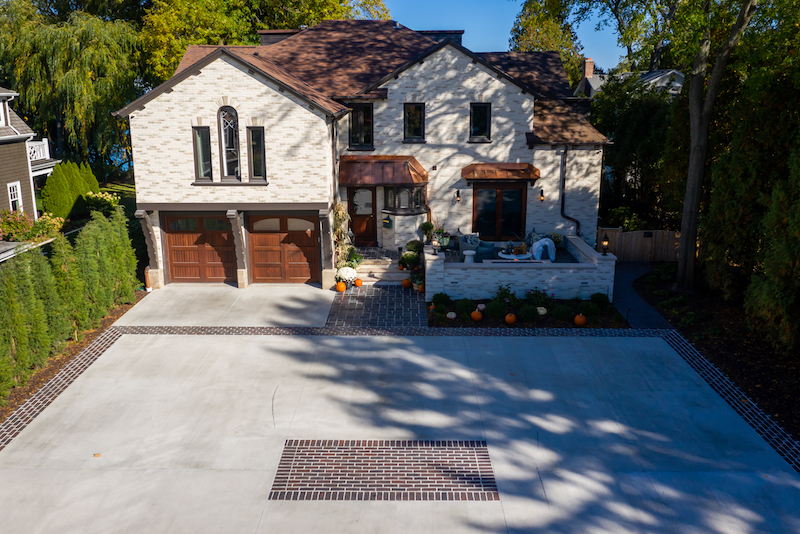
Premium Shingles
These are the most expensive of the asphalt shingles, but are of the highest quality. Premium shingles are larger than both three tab and dimensional shingles and are manufactured to look like slate. In contrast to the other two types of asphalt shingles, premium shingles can last up to 50 years.
| Type | Lifespan (years) | Warranty Length | Underlayment | Roof Pitch (minimum) | Cost |
|---|---|---|---|---|---|
| Three Tab | 25+ | 25 years | No. 15 Felt Paper/Synthetic | 4:12 | $$$$ |
| Dimensional | 30+ | 30 years | No. 15 Felt Paper/Synthetic | 4:12 | $$$$ |
| Premium | Up to a lifetime | Lifetime | No. 15 Felt Paper/Synthetic | 4:12 | $$$$ |
Cedar Shake
Cedar shake roofs are a premium roof material made from cedar (and other) wood materials. One of the more aesthetically pleasing roof materials, cedar allows for a wide range of stain applications, giving you many color options. Cedar shake shingles come in widths from three to eight inches and lengths between 18 and 24 inches. There are two main types of cedar that are used in cedar roofs: white cedar and red cedar.
White Cedar
Of the two, white cedar is the more cost-effective option. Most commonly, manufacturers use Atlantic white cedar, Eastern white cedar and Northern white cedar in roofing. Each of these different types of cedar are resistant to decay, do not splinter and provide excellent stability to your roof.
Red Cedar
Red cedar is more expensive than white cedar, but it is of much higher quality. It is naturally resistant to rot and insect damage, and can withstand varying temperatures and climates. Additionally, red cedar contains tannic acid, which is a preservative that naturally occurs within the wood.
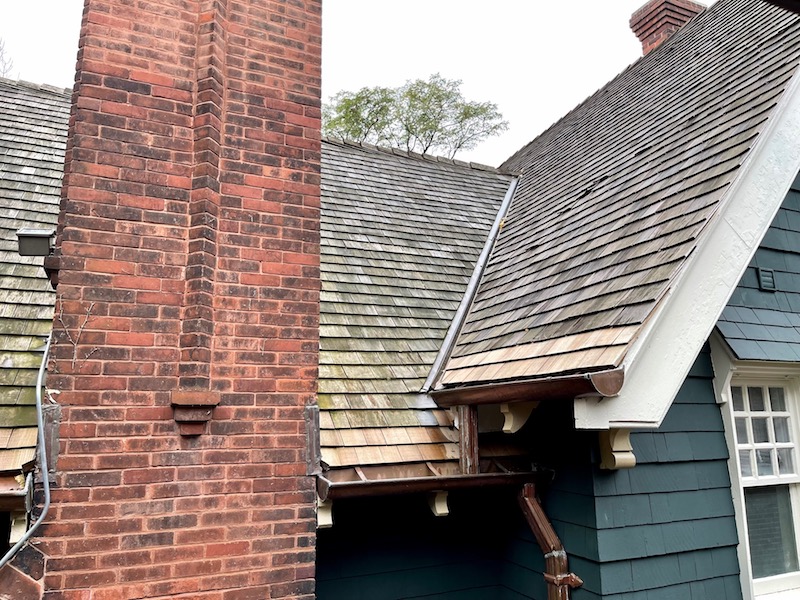
Three Grades
Cedar shake shingles come in three grades: common cedar shake, select cedar shake and 100% straight grain cedar shake.
Common Cedar Shake
This is the the most cost-effective of the three grades. Common cedar shake shingles are randomly cut and made out of any part of the tree. Essentially, they are the leftovers of other cuts. Common cedar shake shingles are the first of the three to split and warp. However, being cedar, it is still strong and retains a rugged look.
Select Cedar Shake
Select cedar shake is a mix of common cedar shake and straight grain cedar shake. It contains around 80% straight grain cedar and around 20% common cedar. This can be a good option for those who want a higher quality cedar shake shingle but do not want to pay highest price.
100% Straight Grain Cedar Shake
This is the highest quality cedar shake shingle on the market. Each shingle is hand selected and straight grained. Because each shingle is straight grained, the shingles will never curl up and warp. It is the most expensive option, but for those looking for longevity and high-quality, this is by far the best option of the cedar shake shingles.
Cedar Breather®
One of the best underlayment options for cedar roofing is Cedar Breather®. This underlayment provides a space for continuous airflow between the solid roof deck and the shingles or shakes. Cedar Breather® is fire resistant, reduces potential rotting and protects the beauty and life of cedar roofing.
| Type | Lifespan (years) | Warranty Length* | Underlayment | Roof Pitch (minimum) | Cost |
|---|---|---|---|---|---|
| Common Shake | 30+ | N/A | Felt/Tar Paper, Synthetic or Cedar Breather® | 5:12 | $$$$ |
| Select Shake | 30+ | N/A | Felt/Tar Paper, Synthetic or Cedar Breather® | 5:12 | $$$$ |
| Straight Grain | 30+ | N/A | Felt/Tar Paper, Synthetic or Cedar Breather® | 5:12 | $$$$ |
*Warranty varies depending on the manufacturer
Slate
The heaviest of the roofing materials, slate has long been lauded for its durability and longevity. Because of this, it is one of the most expensive roofing materials around. Mined (mostly in Italy), and cut into square tiles, builders must install slate tiles one at a time. Slate is extremely heavy, so if you choose this option, we build a framework strong enough to support it. If properly installed and flashed, a slate roof will last a lifetime.

Clay Tiles
Clay is one of the oldest roofing materials, dating back to China over 12,000 years ago. In the United States, Ludowici has been making shingles continuously since 1888. However, not every climate is right for clay, which is why you rarely see clay roofs in Wisconsin. Clay is one of the heavier roof options; it is over three times heavier than asphalt shingles. The iron content in clay is what produces its natural red color, but some clay tiles roofers glaze to feature any color you desire.
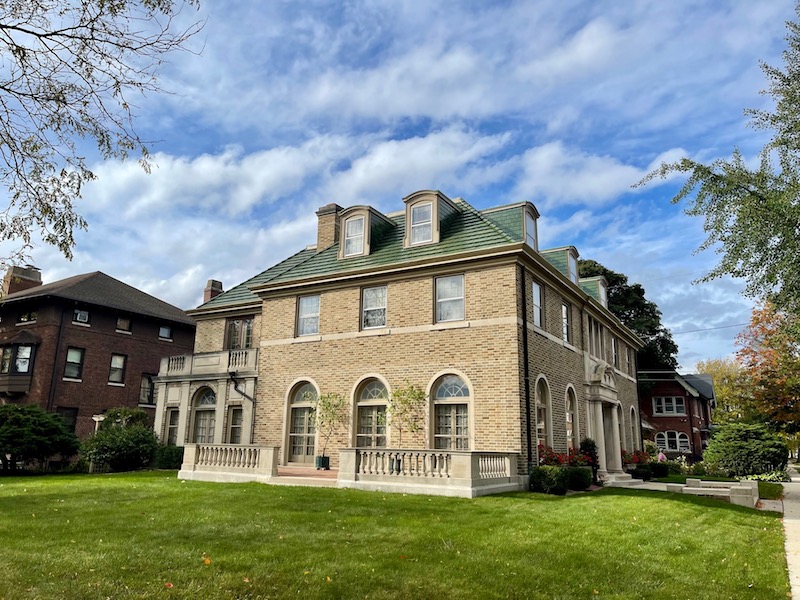
Composite Synthetic
Made to mimic cedar or slate, composite synthetic shingles are made of a highly durable plastic. We suggest using DaVinci composite synthetic shingles in a home remodeling project. DaVinci makes these tiles from plastic, meaning they are much lighter than the materials they mimic, and in turn, the framing of your house does not to be as load-bearing.
| Type | Lifespan (years) | Warranty Length | Underlayment | Roof Pitch (minimum) | Cost |
|---|---|---|---|---|---|
| Slate | Lifetime | N/A* | No. 30 asphalt organic felt | 4:12 | $$$$ |
| Clay | 75-100 | 50+ | No. 30 organic felt | 4:12 | $$$$ |
| Composite | Lifetime | Lifetime | No. 30 organic felt (minimum) | 3-4:12 | $$$$ |
*Slate is a naturally occurring material so there is no manufacturer warranty
Corrugated Fiberglass Panels
Corrugated fiberglass roof panels are most commonly used to cover areas where you need light but need to limit the heat. Areas such as patios, greenhouses (and other agricultural structures), backyards and carports. These are more cost-effective than other roofing materials but still provide a good amount of durability. Additionally, corrugated fiberglass can withstand harsh weather and is fire, rot and corrosion resistant.
Solar Roof
The Solar Roof, a product of Tesla, is a series of solar and non-solar shingles combined to make a singular roof. Tesla makes the roof out of photovoltaic tiles. Just like solar panels, sunlight powers the roof. The direct current that sunlight produces is sent to a solar inverter which converts that energy to an alternating current that can power your home. While it is expensive up front, Tesla claims “in most cases, it ultimately pays for itself by reducing or eliminating a home’s electricity bill,”. The biggest downside to the Solar Roof is that it is new technology and only comes with a 25 year warranty, which is far less than many of the other roofing materials listed.
Guide to Roofs: Flat Roof Materials
EPDM
Ethylene propylene diene monomer (EPDM) is one of the most common materials used in flat roofs. Manufacturers make EPDM out of true rubber; it’s lightweight and resistant to scuffs and tears. Like many of the other materials used for flat roofs, once installed, the EPDM is covered by stones to protect it from the elements.
TPO
Thermoplastic polyolefin (TPO) is another of the common flat roof materials. Manufacturers make TPO out of rubber and other synthetics and can last up to thirty years if properly installed. One reason many people elect to have this material used in their flat roof is that it’s naturally reflective to UV rays, keeping the building much cooler.
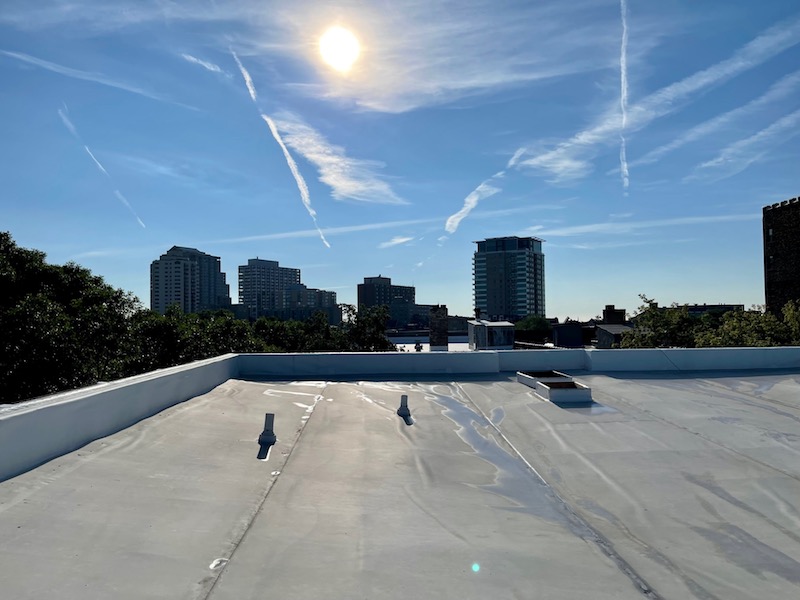
Torch Down
Manufacturers make torch down roofing out of sheets of modified bitumen. Roofers adhere the bitumen to the surface using a torch, hence the name. This process helps to create a waterproof seal for the roof. There are two types of torch down: two-layer and three-layer. The two-layer torch down has a base layer and a cap sheet. The three-layer torch down has a base layer, cap sheet and a granulate cap sheet. This additional granulate cap sheet helps to extend the life of the roof, enhance fire resistance and provide more energy efficiency to the structure.
Dec-Tec™
This flat roof material is much more common in residential use than the others mentioned above. Dec-Tec™ is a waterproof membrane most commonly used for decks, balconies and walkways. Manufacturers do not design traditional roofing for foot traffic, and this is where Dec-Tec™ comes into play. The company offers a ten or twenty year warranty, depending on which product you select.
Guide to Roofs: In Conclusion
While you may not think about your roof very often, it’s design and materials are integral to the safety and quality of your home. At LaBonte Construction we have years of experience installing high quality roofs, ensuring that the roof of your home remodeling project will last. If you would like to discuss the type of roof for your next home remodel, or have any other question about a home remodeling project, please contact us.
